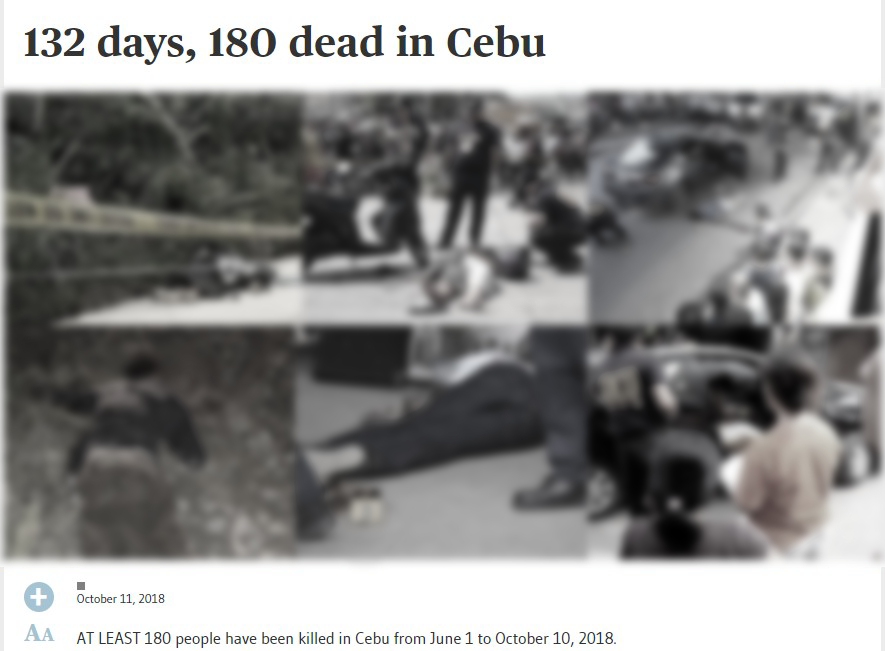Just More Killings?

Screengrab from SunStar Cebu website.
SINCE JULY 2016, anti-illegal drug operations have been a staple of media reports. The enforcers of an already controversial policy, the police are often accused of planting evidence, or worse, of extrajudicial killings.
A killing in Barangay Malubog, Cebu City last October 4 left five persons dead. Two survivors allege that they were abducted by six persons who introduced themselves as policemen. They were brought to a hilly area where they said their captors shot them one by one. The survivors said they escaped by rolling down the hill and hiding in the tall grass.
A few news accounts noted that the incident happened during a “one-time, big-time” operation by the regional police during which nine other persons were killed. C/Supt. Debold Sinas, Central Visayas police director, denied that his men were involved in the Malubog incident.
Should the survivors’ allegations turn out to be true, it would be another blow to the already tarnished image of the police. Most of the media, however, did not even pay much attention to the killings. Those that did report them did not connect the incidents to the continuing cost in lives of the Duterte regime’s bloody “war on drugs.”
CMFR monitored reports from the Manila broadsheets Manila Bulletin, the Philippine Daily Inquirer and The Philippine Star; the primetime newscasts 24 Oras (GMA-7), Aksyon (TV5), News Night (CNN Philippines) and TV Patrol (ABS-CBN 2); as well as selected online news websites from October 4 to October 14, 2018.
Not thoroughly explored
The spate of killings in Cebu did not get the media attention it deserved.
In television, only primetime newscasts Aksyon and 24 Oras picked up the subject during the monitor period. Their reports included the survivors’ claims that policemen were behind the killings, which was promptly denied by regional police officials.
Some context was provided by 24 Oras in its October 5 report, which recalled that the incident coincided with the regional police’s conduct of a “one-time, big-time” operation in Cebu City, Lapu-Lapu City and Talisay City. It also recalled the latest drug war casualty numbers by the Philippine Drug Enforcement Agency (PDEA). The same report was also aired in GMA News TV’s news program State of the Nation with Jessica Soho (SONA).
SONA’s follow-up report on October 8 featured a conversation between the reporter and news anchor Jessica Soho, who recalled that Cebu had not figured much in past anti-drug operations. The GMA 7 reporter said the police have conducted “one-time, big-time operations” once a month over the last three months, and that they began under the leadership of the new PNP regional director.
In print, the Inquirer provided the most space on the killings with five reports, while the Bulletin had two, and the Star, one. These reports came after initial news accounts in television. But the newspapers carried only information already provided by TV reports and did not offer anything new, except for a few more details on the survivors’ ordeal and their recalling the Senate minority bloc’s intention to look into the Cebu killings.
Context Missing
The killings are far from being new. A Rappler report on October 10, the first of a three-part series, noted that the number of killings in Cebu has risen under the watch of Central Visayas Police Director Sinas and S/Supt. Royina Garma, chief of the Cebu City Police Office. A list published by SunStar Cebu on October 11, meanwhile, showed that from June 1 to October 10 this year, there had been at least 180 people killed in the region.
The context in which the killings are occurring should have figured more prominently in the rest of the media’s reportage. Unfortunately, the above information did not make it to the newspapers. Neither was it provided by the television news programs, which have a longer audience reach.
CMFR has many times pointed out that context is crucial to public understanding of the issues that should concern it. In this instance, coverage without context desensitizes the public to violence, and makes killings the new normal.
The media need to report such incidents as the Cebu killings as part of a bigger picture. Reported as just another crime story, they may not seem significant. But when reported in the wider context of the government’s “drug war,” they can provide media audiences a better appreciation of the extent of the problem the campaign has generated.
Leave a Reply